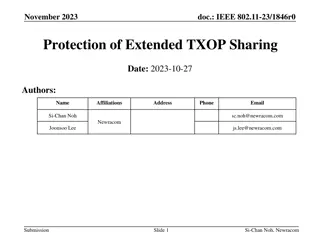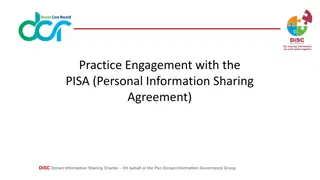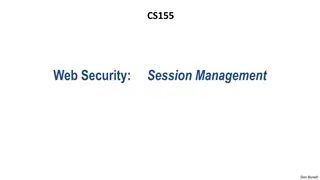Understanding Web Security: Cross-Origin Resource Sharing & Same-Origin Policy
Exploring the concepts of Cross-Origin Resource Sharing (CORS) and Same-Origin Policy (SOP) in web security, including their implications on data sharing between different origins and how browsers enforce security restrictions to prevent unauthorized access.
Download Presentation

Please find below an Image/Link to download the presentation.
The content on the website is provided AS IS for your information and personal use only. It may not be sold, licensed, or shared on other websites without obtaining consent from the author. Download presentation by click this link. If you encounter any issues during the download, it is possible that the publisher has removed the file from their server.
E N D
Presentation Transcript
Cross-Origin Resource Sharing COMP3220 Web Infrastructure Dr Nicholas Gibbins nmg@ecs.soton.ac.uk
Cross-Site Request Forgery If user agents allow one origin to talk to a different origin, there may be security issues User agent will send cookies if available and applicable Privilege escalation attack confused deputy GET dodgysite.org .js XMLHttpRequest trustedsite.com 3
Same-Origin Policy By default, browsers restrict how a resource from one origin interacts with resources from other origins GET dodgysite.org .js Fetch/XMLHttpRequest trustedsite.com Barth, A. (2011) The Web Origin Concept. RFC6454. Available online at: https://tools.ietf.org/html/rfc6454 4
Same-Origin Policy Two resources have the same origin if: Their URIs use the same protocol (i.e. no mixing of http and https) Their URIs have the same host Their URIs have the same port (path is ignored for the purposes of determining origin) 5
Same-Origin Policy All the same origin All different origins http://example.org/ http://example.org/ http://example.org:80/ https://example.org/ http://example.org/foo http://example.org:8080/ http://www.example.org/ http://example.com/ https://example.org:80/ 6
Same-Origin Policy By default, the SOP blocks cross-origin reads by the browser Exception: embedded resources: Media (img/audio/video) external stylesheets (<link rel="stylesheet" href="..."/>) scripts (<script src="..."></script>) @font-face (some variability between browsers) iframe Cross-origin POSTS that result from form submission are allowed 7
Cross-Origin Resource Sharing Mechanism for selectively relaxing the Same-Origin Policy At a protocol level: Adds new headers that let servers indicate which origins may make requests Restricts the headers which may be sent in requests (i.e. avoiding taint) Restricts the headers which may be received in responses At an API level: CORS requests sent via fetch() API Client-side enforcement Disallowed request may still result in a message being sent by the browser Result of a disallowed request is not sent to the script by the browser Reason for CORS error written to browser console, but not available to script 8
CORS requests Simple requests satisfy all of the following GET, HEAD or POST only Accept:, Accept-Language:, Content-Type: or Content-Language: are the only headers set manually Content-Type: is one of text/plain, application/x-www-form-urlencode or multipart/formdata only All other requests trigger a CORS preflight 9
CORS flow yes GET/HEAD? call fetch() no yes yes no standard Content-Type? custom headers? POST? execute fetch() yes no no yes access granted? send OPTIONS no error preflight 10
CORS headers Client header Origin: - like Referer:,but excludes path (automatically added by browser) Access-Control-Request-Method: used in preflight (see later) Access-Control-Request-Headers: used in preflight (see later) Server headers Access-Control-Allow-Origin: which origins are accepted? (* for any) Access-Control-Allow-Methods: which methods are accepted? Access-Control-Allow-Headers: which headers are accepted? Access-Control-Max-Age: for how long is a preflight check valid? Access-Control-Allow-Credentials: include cookies (etc) in request 11
Simple request example GET /page.html site-a.org .js fetch("http://site-b.com/bar.json") site-b.org 12
Simple request example // in a script in https://site-a.org/page.html fetch("https://site-b.org/bar.json", {mode: "cors", method: "GET"}) .then(response => { if (!response.ok) { throw new Error("HTTP status " + response.status); } return response.json(); }) .then(data => console.log(data)) .catch(error => { console.error("Error: " + error); }); 13
Simple request example fetch() GET /bar.json HTTP/1.1 Host: site-b.org Origin: https://site-a.org HTTP/1.1 200 OK Access-Control-Allow-Origin: https://site-a.org Vary: origin response ... 14
Simple request example fetch() GET /bar.json HTTP/1.1 Host: site-b.org Origin: https://site-a.org HTTP/1.1 200 OK Access-Control-Allow-Origin: * Vary: origin response ... 15
Simple request example fetch() GET /bar.json HTTP/1.1 Host: site-b.org Origin: https://site-c.org HTTP/1.1 403 Forbidden Access-Control-Allow-Origin: https://site-a.org/ Vary: origin error ... Reason: CORS header 'Access-Control-Allow-Origin' does not match 'https://site-c.org/' 16
Preflight requests Unsafe requests (POST, PUT, DELETE ) require a preflight check Client sends an OPTIONS message to determine if the intended request may be sent Access-Control-Request-*: headers used to express intended request Server responds with Access-Control-Allow-*: headers to express permissions 17
Preflight request example // in a script in https://site-a.org/page.html fetch("https://site-b.org/qux.json", {mode: "cors", method: "PUT", body: <...>}) .then(response => { if (!response.ok) { throw new Error("HTTP status " + response.status); } return response.json(); }) .then(data => console.log(data)) .catch(error => { console.error("Error: " + error); }); 18
OPTIONS /qux.json HTTP/1.1 Host: site-b.org Origin: https://site-a.org Access-Control-Request-Method: PUT fetch() HTTP/1.1 204 No Content Access-Control-Allow-Origin: https://site-a.org Access-Control-Allow-Methods: GET, PUT, OPTIONS PUT /qux.json HTTP/1.1 Host: site-b.org Origin: https://site-a.org HTTP/1.1 200 OK Access-Control-Allow-Origin: https://site-a.org Access-Control-Allow-Methods: GET, PUT, OPTIONS response 19
OPTIONS /qux.json HTTP/1.1 Host: site-b.org Origin: https://site-a.org Access-Control-Request-Method: PUT fetch() HTTP/1.1 204 No Content Access-Control-Allow-Origin: https://site-a.org Access-Control-Allow-Methods: GET, OPTIONS error Reason: Did not find method in CORS header 'Access-Control-Allow-Methods' 20
Further reading Barth, A. (2011) The Web Origin Concept. RFC6454 https://tools.ietf.org/html/rfc6454 CORS for developers https://w3c.github.io/webappsec-cors-for-developers/ HTML5 Fetch API https://fetch.spec.whatwg.org/ Cross-Origin Resource Sharing at MDN https://developer.mozilla.org/en-US/docs/Web/HTTP/CORS 21























